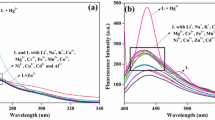Abstract
Merocyanine dye based fluorescent organic compound has been synthesized for the detection of glutamine. The probe showed remarkable fluorescent intensity with glutamine through ICT (Intermolecular Charge Transfer Mechanism). Hence, it is tested for the detection of glutamine using colorimetric and fluorimetric techniques in physiological and neutral pH (7.2). Under optimized experimental conditions, the probe detects glutamine selectively among other interfering biomolecules. The probe has showed a LOD (lower limit of detection) of 9.6 × 10–8 mol/L at the linear range 0–180 µM towards glutamine. The practical application of the probe is successfully tested in human biofluids.
Graphical abstract














Similar content being viewed by others
Data Availability
All relevant data are within the paper and its Supporting Information files.
References
Alil J, Najeeb J, Alil MA, Aslam MF, Raza A (2017) J Biosens Bioelectron 8:1–9
Stetter JR, Hesketh PJ, Hunter GW (2006) Electrochem Soc Interface 15:66–69
Fadel FI, Elshamaa MF, Essam RG, Elghoroury EA, Saeed GS, Toukhy SE, Ibrahim MH (2014) Int J Biomed Sci 10:36–42
Choi YK, Park KG (2018) Biomol Ther 26:19–28
Shimmura C, Suda S, Tsuchiya KJ, Hashimoto K, Ohno K, Matsuzaki H, Iwata K, Matsumoto K, Wakuda T, Kameno Y, Suzuki K (2011) PLoS One 6:25340–25346
Watford M (2018) J Nutr 138:2003–2007
Counihan JL, Grossman EA, Nomura DK (2018) Chem Rev 118:6893–6923
Zhang J, Pavlova NN, Thompson CB (2017) EMBO 36:1302–1315
Lukey MJ, Wilson KF, Cerione RA (2013) Future Med Chem 5:1685–1700
Valeur B, Santos MNB (2011) J Chem Educ 88:731–738
Still ER, Yuneva MO (2017) Br J Cancer 116:1375–1381
Mehrotra P (2016) J Oral Biol Craniofac Res 6:153–159
Jin L, Alesi GN, Kang S (2016) Oncogene 35:3619–3625
Stefano LD, Rotiroti L, Rendina I, Moretti L, Scognamiglio V, Rossi M, Auria SD (2006) Biosens Bioelectron 21:1664–1667
Cattaneo MV, Luong JHT, Mercille S (1992) Biosens Bioelectron 7:329–334
Forni A, Lucenti E, Bottab C, Cariati E (2018) J Mater Chem C 6:4603–4626
Boyr F, Botre C, Lorenti G, Mazzeij F, Porcellio F, Scibonao G (1993) J Pharm Biomed Anal 11:679–686
Pejcic FB, Marco RD, Parkinson G (2006) Analyst 131:1079–1090
Tsujino L, Miyagi K, Sampson RW, Sieber F (2006) Photochem Photobiol 82:458–465
Guo Z, Kim G-H, Shin I, Yoon J (2012) Biomaterials 33:7818–7827
Su B, Chen FZ, Wang QM (2013) J Org Chem 78:2775–2779
Cuihua X, Venkat RRD, Haiying L (2006) Macromolecules 39:5747–5752
Ponnuvel K, Ramamoorthy J, Sivaraman G, Padmini V (2018) ChemistrySelect 3:12150–12154
Adak AK, Dutta B, Manna SK, Sinha C (2019) ACS Omega 4:18987–18995
Han J, Burgess K (2010) Chem Rev 110:2709–2728
Lin X, Chun L, Hua J (2009) Org Lett 11:1655–1658
Senthilkumar T, Asha SK (2015) Macromolecules 48:3449–3461
Ellairaja S, Shenbagavalli K, Ponmariappan S, Vasantha VS (2017) Biosens Bioelectron 91:82–88
Liu L, Lin H (2014) Anal Chem 86:8829–8834
Ao H, Feng H, Zhao M, Zhao M, Chen J, Qian Z (2017) ACS Sens 2:1692–1699
Udhayakumari D, Naha S, Velmathi S (2017) Anal Methods 9:552–578
Frisch MJ, Trucks GW, Schlegel HB, Scuseria GE, Robb MA, Cheeseman JR, Scalmani G, Barone V, Mennucci B, Petersson GA, Nakatsuji H, Caricato M, Li X, Hratchian HP, Izmaylov AF, Bloino J, Zheng G, Sonnenberg JL, Hada M, Ehara M, Toyota K, Fukuda R, Hasegawa J, Ishida M, Nakajima T, Honda Y, Kitao O, Nakai H, Vreven T, Montgomery JA Jr, Peralta JE, Ogliaro F, Bearpark M, Heyd JJ, Brothers E, Kudin KN, Staroverov VN, Kobayashi R, Normand J, Raghavachari K, Rendell A, Burant JC, Iyengar SS, Tomasi J, Cossi M, Rega N, Millam JM, Klene M, Knox JE, Cross JB, Bakken V, Adamo C, Jaramillo J, Gomperts R, Stratmann RE, Yazyev O, Austin AJ, Cammi R, Pomelli C, Ochterski JW, Martin RL, Morokuma K, Zakrzewski VG, Voth GA, Salvador P, Dannenberg JJ, Dapprich S, Daniels AD, Farkas O, Foresman JB, Ortiz JV, Cioslowski J, Fox DJ (2009) Gaussian 09, Revision A.02, Gaussian Inc., Wallingford, CT
(a). Grimme S (2006) J Comput Chem 27:1787–1799 (b). Deepa A, Padmini V (2019) J Fluoresc 29:813–818
Stefano LD, Rossi M, Staiano M, Mamone G, Parracino A, Rotiroti L, Rendina I, Rossi M, Auria SD (2006) J Proteome Res 5:1241–1245
Acknowledgements
The author VS acknowledged DST, New Delhi for the INSPIRE fellowship (IF180132). Authors thank for financial support under DST-IRHPA, FIST, RUSA-MKU and PURSE for instrument facilities.
Funding
The authors received no specific funding for this work.
Author information
Authors and Affiliations
Contributions
Vijayakumar Sathya: Conceptualization, Writing-original draft. Appadurai Deepa: Revising the article. Lakshmi Kandhan Sangeetha: Revising the article. Venkatesan Srinivasadesikan: Software resources. Shyi-Long Lee: Software resources. Vediappen Padmini: Supervision, Writing-review.
Corresponding author
Ethics declarations
Ethics Approval
Not applicable.
Consent to Participate
Not applicable.
Consent for Publication
Not applicable.
Conflicts of Interest
The authors have no conflict of interest in this research.
Additional information
Publisher's Note
Springer Nature remains neutral with regard to jurisdictional claims in published maps and institutional affiliations.
Highlights
• The organic sensor of merocyanine dye was synthesized by a simple condensation method with moderate yield.
• The dye as a sensor detects the glutamine with high fluorescence intensity.
• The sensor was selectively detects glutamine while interfering other biomolecules and biologically important metals.
Supplementary Information
Below is the link to the electronic supplementary material.
Rights and permissions
About this article
Cite this article
Sathya, V., Deepa, A., Sangeetha, L.K. et al. Development of Optical Biosensor for the Detection of Glutamine in Human Biofluids Using Merocyanine Dye. J Fluoresc 32, 1389–1396 (2022). https://doi.org/10.1007/s10895-022-02937-y
Received:
Accepted:
Published:
Issue Date:
DOI: https://doi.org/10.1007/s10895-022-02937-y




